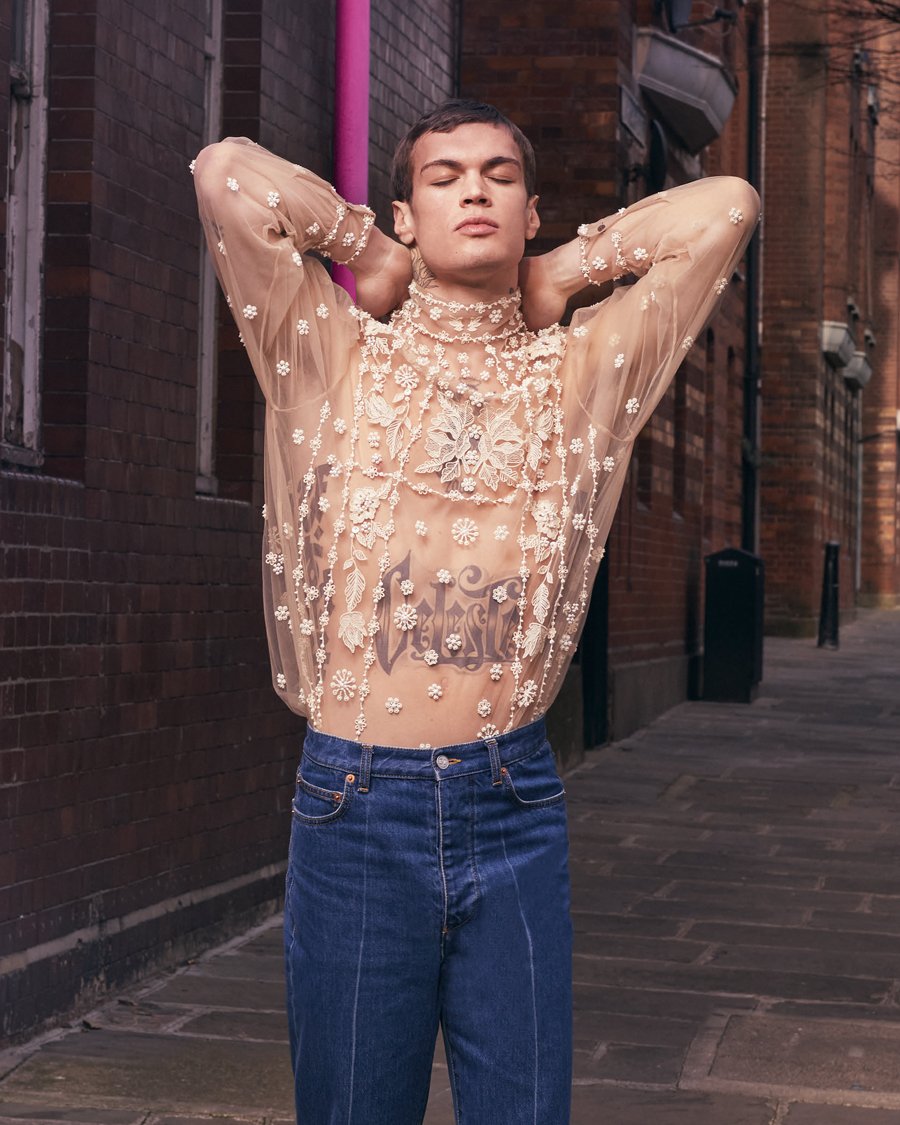A TOUCH OF THE POET
Valentino’s Pierpaolo Piccioli is making romanticism an achingly personal expression of identity and individuality.
By MAX BERLINGER
Photography MICHAEL BAILEY GATES
Valentino is often thought of in terms of dazzling dresses or flowing couture gowns but lately the Roman brand is taking its designs out of the salons and the ornately designer, grandiose buildings and into the public square. One can’t help but ask – Is Valentino coming down from its ivory tower?
Well, yes and no.
Creative director, Pierpaolo Piccioli has proven a master at injecting a sense of swooning romance into everyday clothes and, conversely, designing ready-to-wear that’s glamorous yet feels as comfortable as a pair of jeans and a T-shirt. His clothes are intentional, celebratory, and lack any pretense of snobbery. It’s this tension that gives the brand a frisson of excitement and grounds it in the realities of modern life. His fashion is a dream, but it’s meant for waking life.
How does Piccioli, who has been in charge of the brand since 2008, and where he worked on the designs jointly with Maria Grazia Chiuri until 2016, resolve these two opposing forces – the romance of fashion and its reality? “I feel that romanticism is an individual approach to life,” he explained. “I don’t think romanticism is about prettiness. For me, romanticism is something that is not objective, just subjective. An individual approach, of course, is about yourself, is personal, is intimate. Sometimes, you cannot explain the reason for your choices – because it’s not objective. But I think that today it is most important to express yourself, to be yourself, to be very close to your identity. That’s the only thing that makes you different.”
Valentino has long been synonymous with an Old World charm – it brings to mind drawing rooms on the Upper East Side or Mayfair populated with socialites and their paramours and its suave founder, with his slicked hair and tan skin. Those days are gone, and Piccioli’s Valentino acknowledges that with clothing that has a relaxed, nonchalant elegance. It’s made not for dinner parties and charity events, but for our busy lives. And yet it’s not devoid of a certain classic glamour – the lush colors, the vivid prints, the dramatic shapes. It shows how one can take the legacy of a brand and move it into contemporary times. Piccioli’s work is a master class of using a brand’s archive to set down a firm foundation for the future.
That sense of playful individuality and expressing oneself has been the animating force of Piccioli’s recent collections, be it in the rarefied worlds of couture, where the everyday uniform is elevated to the highest form of craftsmanship, or his ready-to-wear collections that possess a sense of casual, off-handed elegance. This is a demonstration of the brand’s signature savoir-faire and discernment, yet made for a youthful, cool consumer. A window into how Piccioli is able to bring together the extremes of fashion, the dream of glamor married to the beauty of daily life.
In his work, Piccioli deals mostly with aesthetics – searching for and creating beauty for its own sake. But that doesn’t mean his designs don’t rub up against more metaphysical, philosophical concerns. “I feel that beauty is about grace,” he said. “Grace is not something you can describe, it’s something else – a perception. When I talk with my premières, I never say, ‘I want a centimetre less.’ I say, ‘I would like the dress to move this way, to give this kind of sensation.’ They are so good at their job, they can translate my intention, my idea.”
Interestingly, Valentino has been able to cut through the noise of the social media age with designs that feel achingly personal – the airiness of his couture designs are begging to be touched while the sensual shapes in his ready-to-wear are made to be worn, not just gazed at on a smartphone screen. “To me, luxury is closest to the idea of humanity,” Piccioli explained. That’s the perfect word – humanity. His work feels, at its core, about the wearer, about creating not just a look, but a feeling for the human wearing the clothes. “We are looking for emotional connections much more than any expensive fabric,” he continued. “I don't think that's the big concern. It's something that gives you emotion. And when we talked about exclusivity, it didn’t make sense to me. And neither does inclusivity as just a word. I feel that the image has a power and has a strength. And you use your own language. So fashion is my language.”
The idea of individuality and inclusivity have been an important part of Piccioli’s work in recent years. His runways have been filled not just with models, but characters, interesting personalities who range in ethnicity, age, body type and appearance. This casting choice that’s not only a push for diversity, but an expansion of who Valentino is for – seemingly, these days it's for every type of person.
“As a fashion designer, I want to use my voice to send messages and values that I believe in,” he said, elucidating how a fashion brand can, in its way, move culture. “Through the beauty of the clothes, you can invite people to express themselves however they want to be, wherever they want to be. As a designer, I never want to be what people expect me to be. Wanting to be very faithful to my identity and being different became a value. Now, as the creative director of Valentino, I’m still the same, more or less. I still feel as though every collection is an opportunity to tell something.”
Perhaps that’s what gives Piccioli’s Valentino so much power – his desire to “tell something” as he calls it. His sense of story or narrative imbues the clothing with a drama that’s then brought to life by the diverse assortment of models he uses. These are his characters and the costumes they would wear, this seems to say. And as this story unfolds, beneath the beauty, a stirring message comes through.
This is all by design, of course. “I have political thoughts,” he said. “And I need to tell them, through my language, which is fashion. So, images. If I were a politician, I would be using words. I chose to be a fashion designer, and I want to use my voice to deliver my values. But I think to be relevant is to do it through images because sometimes you can be even more assertive. Not talking, not writing, but through image, through fashion. It’s like a book and a movie – when you read, you have your imagination, you create your own world. With a movie, it’s already there. Fashion can be super-powerful, like a movie – it’s already there.”
These past few years have been trying times for many – the entire world has gone through a vast amount of change. Fashion can sometimes feel superfluous and yet, to dream is to be human. Even in the darkest times, we dream. Piccioli knows his medium – fashion – and his message – to dream. On the Valentino runway, dreams are always present, in dazzling technicolor, in the most luxurious fabrics, made in sweeping, sensual silhouettes. But what we’re left with the most is the stirring emotion. Or as he explained it, “Art is for art's sake and fashion has to do with the body. But what they have in common is that you can create beauty, and you can create curiosity and interest. You can generate emotions that create thoughts.”



